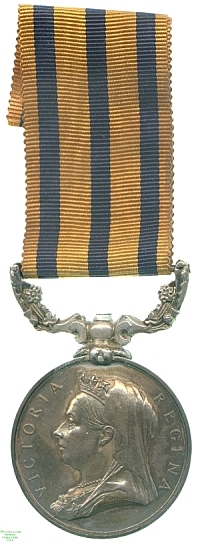
Obverse, a bust of Queen Victoria in veils

Reverse, a lion with a spear in his chest leaping over African native wargear, with brush behind

Obverse, a bust of Queen Victoria in veils |

Reverse, a lion with a spear in his chest leaping over African native wargear, with brush behind |
The British South Africa Company was established by Cecil Rhodes in an attempt to match the successes of the British East India Company from the base of the British Cape Colony (now South Africa) into the briefly-Portuguese territories to the north, an area that was soon known as Rhodesia. The Company, given a royal charter in 1889, recruited its own forces and from 1890 onwards significant engagements resulted in the award of this medal to those troops.
One of their opponents was Lobengula Kumalo, King of the Matabele, a Zulu people who had established a separate nation in the early nineteenth century. This nation became one of the BSAC's target territories and fear of the imminent colonisation led to attacks on Company territories in Bechuanaland (in the Cape Colony, now South Africa) in 1893 and Rhodesia (now Zimbabwe) in 1896, the latter joined by an uprising of the Mashona people, whose province now lies in Zimbabwe and had been annexed in 1890.
It was the suppression of the Mashona uprising, achieved by the capture of the Mashona chiefs, that earnt this medal, which was awarded to Corporal J. Munroe of the British South African Police and is inscribed with the name of the campaign around the upper reverse field. Its suspension is unusual. Lester Watson purchased it from the London dealers Spink at some point before 1928.